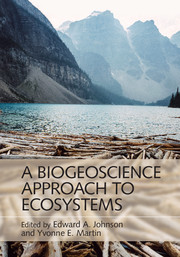Book contents
- Frontmatter
- Contents
- List of contributors
- Preface
- Miscellaneous Frontmatter
- 1 Introduction
- Part I Connecting Ecosystem and Geoscience Processes
- Part II Transport Processes and Conservation Budgets in Biogeoscience
- Part III Coupling Hillslope Geomorphology, Soils, Hydrology, and Ecosystems
- Part IV Coupling Fluvial and Aeolian Geomorphology, Hydrology/Hydraulics, and Ecosystems
- 10 Mechanisms of Flow and Sediment Transport in Fluvial Ecosystems: Physical and Ecological Consequences
- 11 Measuring the Hydraulic Landscapes of Stream-Dwelling Invertebrates for Ecological Research
- 12 Salt Marsh Ecosystems: Tidal Flow, Vegetation, and Carbon Dynamics
- 13 Coastal Dunes and Vegetation Dynamics
- 14 Biogeomorphic Ecosystems within Stressful and Disturbed Environments: A Focus on Termites and Pioneer Plants
- Index
- References
10 - Mechanisms of Flow and Sediment Transport in Fluvial Ecosystems: Physical and Ecological Consequences
from Part IV - Coupling Fluvial and Aeolian Geomorphology, Hydrology/Hydraulics, and Ecosystems
Published online by Cambridge University Press: 27 October 2016
- Frontmatter
- Contents
- List of contributors
- Preface
- Miscellaneous Frontmatter
- 1 Introduction
- Part I Connecting Ecosystem and Geoscience Processes
- Part II Transport Processes and Conservation Budgets in Biogeoscience
- Part III Coupling Hillslope Geomorphology, Soils, Hydrology, and Ecosystems
- Part IV Coupling Fluvial and Aeolian Geomorphology, Hydrology/Hydraulics, and Ecosystems
- 10 Mechanisms of Flow and Sediment Transport in Fluvial Ecosystems: Physical and Ecological Consequences
- 11 Measuring the Hydraulic Landscapes of Stream-Dwelling Invertebrates for Ecological Research
- 12 Salt Marsh Ecosystems: Tidal Flow, Vegetation, and Carbon Dynamics
- 13 Coastal Dunes and Vegetation Dynamics
- 14 Biogeomorphic Ecosystems within Stressful and Disturbed Environments: A Focus on Termites and Pioneer Plants
- Index
- References
Summary
Introduction
Anyone who has spent time in or around rivers will recognize that water flows in complex, ever-changing patterns that are in part determined by the physical shape and roughness of the stream boundaries. Low gradient, deep rivers may look almost like lakes, having very smooth water surfaces giving little indication that the water is flowing at all, while a great deal less water flowing through a steep, cobble-bedded mountain channel may form a turbulent, noisy maelstrom of whitewater (Figure 10.1). It is also true that these complex flow patterns imprint themselves physically upon the riverine environment by eroding, transporting and depositing sediment and organic material, thereby shaping the streams in which the water flows.
Channels that have developed within large deposits of sediment (i.e., floodplains, fans and deltas) have alluvial channel boundaries, meaning that they consist of the sediment transported and deposited by the river itself. These systems are particularly dynamic, in that the boundaries of the stream channel evolve at rates that are appreciable on human timescales; the evolution of these boundaries is determined by the interplay between the forces and energy associated with the flux of water in the stream channel and the quantity and texture of sediment delivered to a stream channel from the surrounding drainage basin. In this way, the behavior of a stream at any given point can be influenced by processes happening anywhere in the drainage basin upstream. As the boundaries of these alluvial streams change, the aquatic ecosystems that they support must adapt.
Hutchinson (1965) described the environment as a stage where plant and animal species play out the theater of life. In many ecosystems, such as boreal and tropical forests on land, or kelp forests in the ocean, plants form much of the three-dimensional structure that forms the ecological stage where individual growth, survival, predation, competition, and community dynamics occur. In streams and rivers, it is the physical structure of the channel itself that forms the dominant habitat template that constrains ecological processes and the adaptations of aquatic organisms. All aspects of the ecology of aquatic organisms – from behavior, growth, and reproduction to avoiding predation – are mediated by the attributes of the flowing water environment.
- Type
- Chapter
- Information
- A Biogeoscience Approach to Ecosystems , pp. 347 - 382Publisher: Cambridge University PressPrint publication year: 2016
References
- 2
- Cited by

